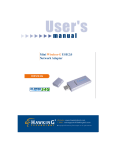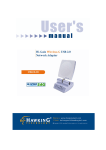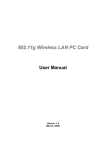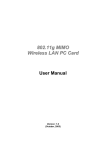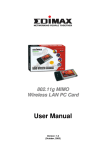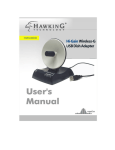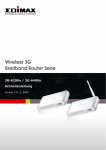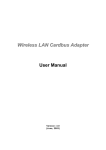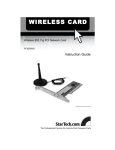Download Edimax EW-7113UHG
Transcript
802.11g Hi-Gain Wireless LAN USB Adapter User Manual Version: 1.0 (March, 2004) COPYRIGHT Copyright ©2004/2005 by this company. All rights reserved. No part of this publication may be reproduced, transmitted, transcribed, stored in a retrieval system, or translated into any language or computer language, in any form or by any means, electronic, mechanical, magnetic, optical, chemical, manual or otherwise, without the prior written permission of this company This company makes no representations or warranties, either expressed or implied, with respect to the contents hereof and specifically disclaims any warranties, merchantability or fitness for any particular purpose. Any software described in this manual is sold or licensed "as is". Should the programs prove defective following their purchase, the buyer (and not this company, its distributor, or its dealer) assumes the entire cost of all necessary servicing, repair, and any incidental or consequential damages resulting from any defect in the software. Further, this company reserves the right to revise this publication and to make changes from time to time in the contents hereof without obligation to notify any person of such revision or changes. All brand and product names mentioned in this manual are trademarks and/or registered trademarks of their respective holders. Federal Communication Commission Interference Statement This equipment has been tested and found to comply with the limits for a Class B digital device, pursuant to Part 15 of FCC Rules. These limits are designed to provide reasonable protection against harmful interference in a residential installation. This equipment generates, uses, and can radiate radio frequency energy and, if not installed and used in accordance with the instructions, may cause harmful interference to radio communications. However, there is no guarantee that interference will not occur in a particular installation. If this equipment does cause harmful interference to radio or television reception, which can be determined by turning the equipment off and on, the user is encouraged to try to correct the interference by one or more of the following measures: 1. Reorient or relocate the receiving antenna. 2. Increase the separation between the equipment and receiver. 3. Connect the equipment into an outlet on a circuit different from that to which the receiver is connected. 4. Consult the dealer or an experienced radio technician for help. FCC Caution This device and its antenna must not be co-located or operating in conjunction with any other antenna or transmitter. This device complies with Part 15 of the FCC Rules. Operation is subject to the following two conditions: (1) this device may not cause harmful interference, and (2) this device must accept any interference received, including interference that may cause undesired operation. Any changes or modifications not expressly approved by the party responsible for compliance could void the authority to operate equipment. Federal Communications Commission (FCC) Radiation Exposure Statement This equipment complies with FCC radiation exposure set forth for an uncontrolled environment. In order to avoid the possibility of exceeding the FCC radio frequency exposure limits, human proximity to the antenna shall not be less than 2.5cm (1 inch) during normal operation. Federal Communications Commission (FCC) RF Exposure Requirements SAR compliance has been established in the laptop computer(s) configurations with PCMCIA slot on the side near the center, as tested in the application for Certification, and can be used in laptop computer(s) with substantially similar physical dimensions, construction, and electrical and RF characteristics. Use in other devices such a PDAs or lappads is not authorized. This transmitter is restricted for use with the specific antenna(s) tested in the application for Certification. The antenna(s) used for this transmitter must not be co-located or operating in conjunction with any other antenna or transmitter. R&TTE Compliance Statement This equipment complies with all the requirements of DIRECTIVE 1999/5/EC OF THE EUROPEAN PARLIAMENT AND THE COUNCIL of March 9, 1999 on radio equipment and telecommunication terminal Equipment and the mutual recognition of their conformity (R&TTE) The R&TTE Directive repeals and replaces in the directive 98/13/EEC (Telecommunications Terminal Equipment and Satellite Earth Station Equipment) As of April 8, 2000. Safety This equipment is designed with the utmost care for the safety of those who install and use it. However, special attention must be paid to the dangers of electric shock and static electricity when working with electrical equipment. All guidelines of this and of the computer manufacture must therefore be allowed at all times to ensure the safe use of the equipment. EU Countries Intended for Use The ETSI version of this device is intended for home and office use in Austria, Belgium, Denmark, Finland, France, Germany, Greece, Ireland, Italy, Luxembourg, the Netherlands, Portugal, Spain, Sweden, and the United Kingdom. The ETSI version of this device is also authorized for use in EFTA member states: Iceland, Liechtenstein, Norway, and Switzerland. EU Countries Not intended for use None. CONTENTS 1 INTRODUCTION ............................................................................. 1 1.1 Features ......................................................................................................................... 1 1.2 Specifications................................................................................................................ 1 1.3 Package Contents .......................................................................................................... 2 2 INSTALLATION PROCEDURE ..................................................... 3 3 CONFIGURATION UTILITY ......................................................... 7 3.1 General.......................................................................................................................... 7 3.1.1 Preference Setting .............................................................................................................. 9 3.1.2 Site Survey..........................................................................................................................9 3.2 Profiles ........................................................................................................................ 10 3.2.1 Configure the Profile ....................................................................................................... 12 3.2.2 Enable WPA..................................................................................................................... 14 3.3 Current Statistics ......................................................................................................... 16 3.4 About........................................................................................................................... 17 4 TROUBLESHOOTING .................................................................. 18 1 Introduction Thank you for purchasing the 802.11g Hi-Gain Wireless LAN USB Adapter. This adapter complies with IEEE 802.11g standard, which supports up to 54Mbps high-speed wireless network connections. It can also work with IEEE 802.11b devices. When the card connects to 11b devices, the link speed will be up to 11Mbps. By integrating with 6dBi Directional Hi-Gain Antenna, this USB Adapter increases the signal strength and the focus of wireless coverage so that the link quality and communication distance are significantly improved. For security issues, this adapter supports 64/128-bit WEP data encryption that protects your wireless network from eavesdropping. It also provides WPA (Wi-Fi Protected Access) feature that combines IEEE 802.1x and TKIP (Temporal Key Integrity Protocol) technologies. With WPA function, users are required to authorize before accessing to APs or AP Routers, and the data transmitted in the network is encrypted/decrypted by a secret key dynamically changed. This adapter supports USB 2.0 interface, which is forty times than USB 1.1 interface. Through the faster data transfer interface, this adapter can deliver more data at a time and raise the data transfer rate to 54Mbps. USB 2.0 is also backward compatible with USB 1.1/1.0 standards, so the adapter can work with PCs or Laptops that only support USB 1.1/1.0 interface. This card is cost-effective, together with the versatile features; it is the best solution for you to build your wireless network. 1.1 Features • • • • • • • • Comply with IEEE 802.11g (2.4GHz, OFDM) and IEEE 802.11b standards. Works with both IEEE 802.11b and IEEE 802.11g products. High-speed transfer data rate - up to 54Mbps. High throughput supports multi-media data bandwidth requirement. Supports 64/128-bit WEP and WPA (TKIP with IEEE 802.1x with) WLAN securities. Automatic data rate fallback increases data security and reliability. Supports the most popular operating system: Windows 98SE/Me/2000/XP. Supports USB 2.0/1.1/1.0 interface. 1.2 Specifications • • • • • Standard: IEEE 802.11b/g Host Interface: USB 2.0/1.1/1.0 USB Port: Mini-USB Frequency Band: 2.4000 ~ 2.4835GHz (Industrial Scientific Medical Band) Modulation: OFDM with BPSK, QPSK, 16QAM, 64QAM (11g) BPSK, QPSK, CCK (11b) 1 • • • • • • • • • • • Data Rate: 54/48/36/24/18/12/11/9/6/5.5/2/1Mbps auto fallback Security: 64/128-bit WEP Data Encryption, WPA (TKIP with IEEE 802.1x) Antenna: 6dBi Directional Hi-Gain Antenna Drivers: Windows 98SE/Me/2000/XP (2000 Service Pack 3 above) LEDs: Power, Link Transmit Power: 20dBm Signal Range: Indoors: Up to 500 ft (150 meters), Outdoors: Up to 2100 ft (650 meters) Dimension: 120(H) x 75(W) x 87(D) mm Temperature: 32~131°F (0 ~55°C) Humidity: Max. 95% (NonCondensing) Certification: FCC, CE 1.3 Package Contents Before you begin the installation, please check the items of your package. The package should include the following items: • One USB Adapter • One USB 2.0 Extension Cable (150 cm) • One Quick Guide • One CD (Driver/Utility/User Manual) If any of the above items is missing, contact your supplier as soon as possible. 2 2 Installation Procedure Before you proceed with the installation, please notice following descriptions. Note: The following installation was operated under Windows XP. (Procedures are similar for Windows 98SE/Me/2000.) Note: The driver of Windows 2000 can only support Windows 2000 Service Pack 3 above. I. Install the Driver A. Insert the Installation CD into your CD-ROM driver. B. Insert the USB adapter to the USB port of your laptop or desktop PC. C. Choose the selection “Install from a list or specific location (Advanced)” and click “Next”. D. Click “Browse” to search for the driver. Choose the location to “D:\Driver\xxx” (“D” is where your CD-ROM Driver, “xxx” is the OS system of your computer) and click “Next”. E. A Windows driver warning message appears, click “Continue Anyway”. 3 F. The wizard will install the driver automatically. Click “Finish” to complete the installation. II. Install the Utility A. Execute the "Utility\setup.exe" program from the installation CD. B. The installShield Wizard box will appear, click “Next” to continue. D. C. Choose the selection “I accept the terms in the license agreement” and click “Next”. 4 Enter your “User Name” and “Organization” which is only for reference, then click “Next”. E. If you want to change the destination folder, click “Change”, or click “Next” to continue. F. The wizard has installed the driver automatically. Click “Finish” to complete the installation. 5 III. Using the Utility Go to Start\All Programs\Envara Configuration Utility and select “Envara Configuration Utility”. You are able to use the utility. 6 3 Configuration Utility The Configuration Utility is a powerful application that helps you configure the adapter and monitor the link status and the statistics during the communication process. However, there are some restrictions on the utility. Before using the utility, you have to know about them. 1. If you want to connect to 11g (up to 54Mbps) network, please ensure to install the adapter to PC or laptop with USB 2.0 interface. This adapter can only support 11b while you connect it to the USB 1.1/1.0 port of your computer. 2. Windows 98SE/Me may not support USB 2.0 interface so that this adapter can only work in 11b mode in that kind of OS system. 3. This adapter will work in 11b mode when the network type is in Ad Hoc mode. It is defines by Wi-Fi organization. If you want to enable the data rate up to 54Mbps (11g), please follow steps listed below. A. Go to “Network Connections”. B. Right Click the “Wireless Network Connection” and select “Properties”. C. From the pop-up screen, click “Configure”. D. Enter into “Advanced” page of the “Properties” screen. E. Change the setting of “IBSS Originator Phy-Mode” from “802.11b” to “802.11g”. 3.1 General From the “General” screen, you can view all the information of the network you are connecting to. 7 Parameter Description Connected to (SSID) Display the wireless network which the adapter is connecting to. Network Mode There are two sorts of network types: Infrastructure and Ad Hoc. This field shows the current network type. Channel / Frequency Display the number of the radio channel and the frequency used for the networking. Max. Network Rate This field shows the maximum link rate of the network, that is 54Mbps for 802.11g and 11Mbps for 11b. Security Display the security setting of the network. “Disabled” mean no security settings of the network. Power Save This field displays the power save scheme for the adapter (that is Max performance/Max battery life/Auto). Active Profile This field shows the current connection profile. Radio Status This field shows the transmitter’s status (On or Off). Enable Radio Button This button is used to enable and disable radio transmission. Link Quality The number of link quality indicates the quality of the link. The higher the percentage, the better the quality. Received This field shows the current received baud rate (measured in Kbytes/sec). Sent This field shows the current sent baud rate (measured in Kbytes/sec). Network Rate The data rate is changed when the environment is different. This field can display the current data rate, so that you can adjust the direction of the adapter or distance from other wireless stations. Preferences Button If you want to change the unit of link quality or the update interval for transmitted and received data, click this button to change the settings. 8 Parameter Description View Site Button To view the available network nearby, click the “View Site” button. 3.1.1 Preference Setting This preference screen enables you to change the unit of link quality or the update interval for transmitted and received data. The default settings is “10” for “Statistics Update Interval” and “Percent” for “Parameter Display Units”. If you want to set up as default values, click “Defaults”. This preference setting also enables you to change the “Country Code”. When you are in different country, you can change the “country code” from here. 3.1.2 Site Survey This screen shows all wireless networks nearby. If you want to connect to any network on the list, double-click the item on the list or click “Connect”, and the adapter will automatically connect to the selected network. 9 Parameter Description Available Networks/AP’s List In the list, you can know the information of wireless networks including Link Quality, Network Name, Mode, Security, etc. This information will help you to decide which network you want to connect. Connect Button Select one of the networks from the list and click “Connect”, the adapter will connect to the network automatically. You can also right click the network and select “Connect”. Save Profile Button Save the selected network to be a profile. This profile will be listed in the profiles list table so that you can easy to connect to the network without from “Site Survey” screen. You can also right click the network and select “Save as Profile”. Edit Connect Button If the connection network has changed the WEP security setting, you can click this button to update the setting of the adapter. Note that the WEP setting has to be the same with the network. You can also right click the connection network and select “Edit Connect”. Rescan Button Click “Rescan” button to collect the associated information of all the wireless networks nearby. AP View/Network View Button This switch button can change the way to display the available networks. “Network View” displays the network information simply. 3.2 Profiles You can manage the connection list from profiles list. It is very convenience for you to connect to one of the networks quickly. 10 Parameter Description Auto-Selection Profiles If a profile is set as an Auto-Selection profile it is used to attempt to automatically connect the adapter to the respective profile in the order of the appearance at startup. The networks ever been connected by the adapter will display in the profile list. If you want to connect to one of the profiles in the list, double-click the item on the list or right click the network and select “Connect”. Additional Profiles You can create additional profiles here as other selections. The adapter will not connect to the additional profiles in the list automatically. If you want to change the connection to one of the profiles, double-click the profile or select the profile and click “Connect”. You can click “New” and “Edit” to configure the profile list. Right Click Function List Add – Add a new profile in the list. Edit – Edit the selected profile. Duplicate – Copy the same profile to the list. Delete – Delete the selected profile. Connect – Connect to the profile. Add/Remove to/from Auto-Selection – Add the profile to the “Auto-Selection Profiles” or remove it from “Auto-Selection Profiles” to “Additional Profiles”. Export Profile – Save the profile as a new file. Import Profiles – Import the profile file to the list. Export All Profiles – Save all the profiles as a new file. 11 3.2.1 Configure the Profile When you click “New” or “Edit”, the “Profile Configuration” screen will be popped up. In the screen, there are two pages including General and Security. General Parameter Description Name To name a recognizable profile name for you to identify the different networks. Network Name (SSID) The SSID (up to 32 printable ASCII characters) is the unique name identified in a WLAN. The ID prevents the unintentional merging of two co-located WLANs. You may specify a SSID for the adapter and then only the device with the same SSID can interconnect to the adapter. Network Mode Infrastructure – This operation mode requires the presence of an 802.11 Access Point. All communication is done via the Access Point. Ad-Hoc – Select this mode if you want to connect to another wireless stations in the Wireless LAN network without through an Access Point. Power Save Enable the adapter in the power saving when it is idle. 12 Parameter Description Channel / Frequency This setting is only available for Ad Hoc mode. The channel setting should be the same with the network you are connecting to. Auto-Select Profile Member If you select the check box, this profile will be put in the “Auto-Selection Profiles” list. Defaults The default values are Ad Hoc mode and channel one. If you want to set up to default, click this button. Encryption Parameter Description Security None – Disable the WEP Data Encryption. WEP – Enable the WEP Data Encryption. When the item is selected, you have to continue setting the WEP Key Length and the encryption keys. Use 802.1x This function is not activated yet. It will not implement if you enable it. 13 Parameter Description Encryption Key (Key1 ~ Key4) Select the default encryption key from Key 1 to Key 4 by selected the radio button. The WEP keys are used to encrypt data transmitted in the wireless network. Fill the text box by following the rules below. 64-bit – Input 10-digit Hex values (in the “A-F”, “a-f” and “0-9” range) as the encryption keys. For example: “0123456aef“. 128-bit – Input 26-digit Hex values (in the “A-F”, “a-f” and “0-9” range) as the encryption keys. For example: “01234567890123456789abcdef“. 3.2.2 Enable WPA Wi-Fi Protected Access (WPA) is a specification of standards-based, interoperable security enhancements that strongly increase the level of data protection (encryption) and access control (authentication) for existing and future wireless LAN systems. The technical components of WPA include Temporal Key Integrity Protocol (TKIP) for dynamic key exchange, and 802.1x for authentication. WPA function is enabled in the following software system: 1. Windows XP Service Pack 1 with Windows XP Support Patch for Wi-Fi Protected Access program in addition. 2. Configure the card by Wireless built-in utility (Wireless Zero Configuration). 1. 2. From here, right click the icon to select “View Available Wireless Networks”. Click “Advanced” from “Wireless Network Connection”. 14 3. Click “Configure” to configure the WPA function for the current network. Parameter Description Network Authentication Open –No authentication is needed among the wireless network. Shared – Only wireless stations using a shared key (WEP Key identified) are allowed to connecting each other. WPA – This mode is for enterprise with an authentication server (Radius Server), WPA-enabled access point, and a WPA-enabled client. Once WPA is enabled, all clients and access points on the network must be WPA-enabled in order to access the network. WPA-PSK – It is a special mode designed for home and small business users who do not have access to network authentication servers. In this mode, known as Pre-Shared Key, the user manually enters the starting password in their access point or gateway, as well as in each PC on the wireless network. WPA takes over automatically from that point, keeping unauthorized users that don't have the matching password from joining the network, while encrypting the data traveling between authorized devices. 15 Parameter Description Data Encryption WEP – In WPA or WPA-PSK mode, WEP is also able to be the encryption method for the transmission data. TKIP – TKIP (Temporal Key Integrity Protocol) changes the temporal key every 10,000 packets (a packet is a kind of message transmitted over a network.) This insures much greater security than the standard WEP security. Note: All devices in the network should use the same encryption method to ensure the communication. 3.3 Current Statistics This option enables you to view the sign strength and the statistic information of successful Tx and Rx baud rate. You may reset the counters by clicking “Reset”. The “SNR” indicates the rate of noise and signal in the environment, the bigger of the value, the better of the signal strength. 16 3.4 About By choosing this option, you can view basic information such as the Driver, Firmware and Utility Version. And you can click the hyperlink to connect the website for the information of the wireless chipset vendor. 17 4 Troubleshooting This chapter provides solutions to problems usually encountered during the installation and operation of the adapter. 1. Why can’t the USB adapter work or only work in 11b mode while connect to USB 2.0 port? If this situation occurs, please upgrade the driver of your USB port. This problem may be the compatibility issue with the old driver of the USB port. 2. What is the IEEE 802.11g standard? 802.11g is the new IEEE standard for high-speed wireless LAN communications that provides for up to 54 Mbps data rate in the 2.4 GHz band. 802.11g is quickly becoming the next mainstream wireless LAN technology for the home, office and public networks. 802.11g defines the use of the same OFDM modulation technique specified in IEEE 802.11a for the 5 GHz frequency band and applies it in the same 2.4 GHz frequency band as IEEE 802.11b. The 802.11g standard requires backward compatibility with 802.11b. The standard specifically calls for: A. A new physical layer for the 802.11 Medium Access Control (MAC) in the 2.4 GHz frequency band, known as the extended rate PHY (ERP). The ERP adds OFDM as a mandatory new coding scheme for 6, 12 and 24 Mbps (mandatory speeds), and 18, 36, 48 and 54 Mbps (optional speeds). The ERP includes the modulation schemes found in 802.11b including CCK for 11 and 5.5 Mbps and Barker code modulation for 2 and 1 Mbps. B. A protection mechanism called RTS/CTS that governs how 802.11g devices and 802.11b devices interoperate. 3. What is the IEEE 802.11b standard? The IEEE 802.11b Wireless LAN standard subcommittee, which formulates the standard for the industry. The objective is to enable wireless LAN hardware from different manufactures to communicate. 4. What does IEEE 802.11 feature support? The product supports the following IEEE 802.11 functions: CSMA/CA plus Acknowledge Protocol Multi-Channel Roaming Automatic Rate Selection RTS/CTS Feature Fragmentation Power Management 5. What is Ad-hoc? An Ad-hoc integrated wireless LAN is a group of computers, each has a Wireless LAN adapter, Connected as an independent wireless LAN. Ad hoc wireless LAN is applicable at a departmental scale for a branch or SOHO operation. 18 6. What is Infrastructure? An integrated wireless and wireless and wired LAN is called an Infrastructure configuration. Infrastructure is applicable to enterprise scale for wireless access to central database, or wireless application for mobile workers. 7. What is BSS ID? A specific Ad hoc LAN is called a Basic Service Set (BSS). Computers in a BSS must be configured with the same BSS ID. 8. What is WEP? WEP is Wired Equivalent Privacy, a data privacy mechanism based on a 40 bit shared key algorithm, as described in the IEEE 802 .11 standard. 9. What is TKIP? TKIP is a quick-fix method to quickly overcome the inherent weaknesses in WEP security, especially the reuse of encryption keys. TKIP is involved in the IEEE 802.11i WLAN security standard, and the specification might be officially released by early 2003. 10. What is AES? AES (Advanced Encryption Standard), a chip-based security, has been developed to ensure the highest degree of security and authenticity for digital information, wherever and however communicated or stored, while making more efficient use of hardware and/or software than previous encryption standards. It is also included in IEEE 802.11i standard. Compare with AES, TKIP is a temporary protocol for replacing WEP security until manufacturers implement AES at the hardware level. 11. Can Wireless products support printer sharing? Wireless products perform the same function as LAN products. Therefore, Wireless products can work with Netware, Windows 2000, or other LAN operating systems to support printer or file sharing. 12. Would the information be intercepted while transmitting on air? WLAN features two-fold protection in security. On the hardware side, as with Direct Sequence Spread Spectrum technology, it has the inherent security feature of scrambling. On the software side, WLAN series offer the encryption function (WEP) to enhance security and Access Control. Users can set it up depending upon their needs. 19 13. What is DSSS?What is FHSS?And what are their differences? Frequency-hopping spread-spectrum (FHSS) uses a narrowband carrier that changes frequency in a pattern that is known to both transmitter and receiver. Properly synchronized, the net effect is to maintain a single logical channel. To an unintended receiver, FHSS appears to be short-duration impulse noise. Direct-sequence spread-spectrum (DSSS) generates a redundant bit pattern for each bit to be transmitted. This bit pattern is called a chip (or chipping code). The longer the chip is, the greater the probability that the original data can be recovered. Even if one or more bits in the chip are damaged during transmission, statistical techniques embedded in the radio can recover the original data without-the need for retransmission. To an unintended receiver, DSSS appears as low power wideband noise and is rejected (ignored) by most narrowband receivers. 14. What is Spread Spectrum? Spread Spectrum technology is a wideband radio frequency technique developed by the military for use in reliable, secure, mission-critical communication systems. It is designed to trade off bandwidth efficiency for reliability, integrity, and security. In other words, more bandwidth is consumed than in the case of narrowband transmission, but the trade off produces a signal that is, in effect, louder and thus easier to detect, provided that the receiver knows the parameters of the spread-spectrum signal being broadcast. If a receiver is not tuned to the right frequency, a spread –spectrum signal looks like background noise. There are two main alternatives, Direct Sequence Spread Spectrum (DSSS) and Frequency Hopping Spread Spectrum (FHSS). 20

























